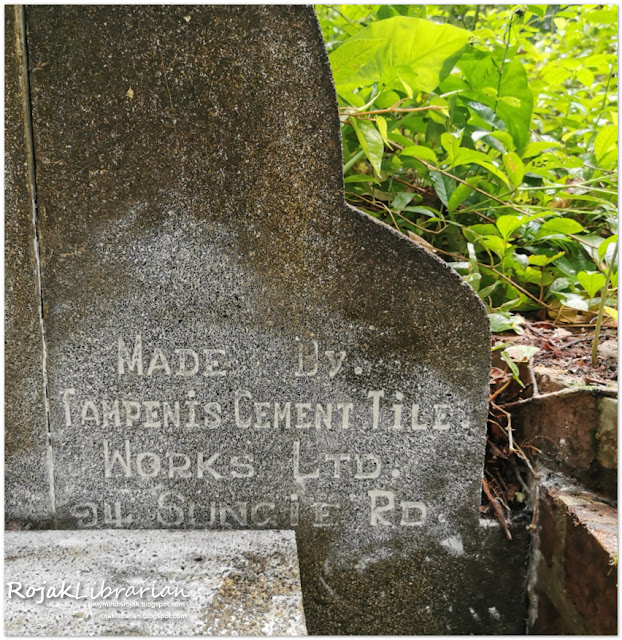It started with a simple tomb made out of cement and concrete and decorated with simple floor cement tiles. The tomb belong to a Mr. Yap Yeow Hin who passed away on 6 June 1922 at the age of 55. What is very unique that we have not seen before was that materials used to make the tomb was by Tampenis Cement Tile Works Ltd. 94 Sungie Road (94 Sungei Road) as clearly listed on the tomb shoulder.
 |
| Tampenis Cement Tile Works Ltd. 94 Sungei Road |
Tampenis Cement Tile Works Limited factory was situated at 94 Sungei Road and likely existed around 1910 and owned by a German firm (R. Forwerg & Co) who introduced the manufacturing of tiles on a large scale in Singapore. They carried on the trade until the outbreak of the Great War (WWI) where under the provision of "The Alien Enemies -Winding-up Ordinance 1914), both R.Forwerg & Co and the Tampenis Cement were force to close. The business then passed into the hands of different owners and among them included Mr. Joseph Aaron Elias. The earliest advertisement i could find is a 1912 advertisement where its factory was already at 94 Sungei Road.
In 1922, Tan Cheng Toon was the managing director and Khoo Tiam Hock was the Superintendent of the factory. Khoo Tiam Hock was its manager in 1925 after serving over 10 years in the firm. Hiring 200 staff (mostly from Java), Tampenis Cement Tile Works produced as much as 6,000 polished tiles per day which is for the local market as well for export to Swatow, Amoy, Pondicherry, Saigon, Java and other eastern countries. It was in operation until 1950's.
 |
| Tampenis Cement Tile Works (1912) |
 |
| Tampenis Cement Tile Works (1915) |
 |
| Tampenis Cement Tile Works (1915) |
 |
| Tampenis Cement Tile Works (1925) |
 |
| Tampenis Cement Tile Works |
 |
| Tampenis Cement Tile Works Ltd (1935) |
 |
| Tampenis Cement Tile Works (1937) |
 |
| Location of Tampenis Cement Tile Works at 94 Sungei Road |
Cement-based tiles manufacturing process
From a URA Conservation Technical Handbook, i got a bit more insight about the manufacturing process and its adoption of the design and patterns of encaustic ceramic tiles. The materials used and manufacturing process were very different. The top finishing layer comprises white cement with color pigments added into the different compartments of the steel "cloisonee moulds". This was then removed, with the grey Portland cement filling the rest of the tile body. The tile was then hydraulically pressed together and left to cure without any need for kiln firing (as opposed to how encaustic tiles are treated and this technique which was patented in France in 1850's greatly reduced the manufacturing cost). Grooved imprints were added for slip resistance. Other that cement flooring tiles, the Tampenis Cement Tile Works also produced terrazo tiles and imitation marble slabs.
 |
| Khoo Thiam Hock at the office of Tampenis Cement Tile Works Limited |
 |
| Bathroom flooring tiles being machine-polished |
 |
| Javanese workers adding colors into the flooring-tile mould |
Where can you find this tiles
From the Newspaper Archive, there where mention that the floor tiles of the St. Joseph's Church were supplied by the Tampenis Tile Works (27 June 1912), Amber Building at Malacca Street (1937) and the new Supreme Court (1935). From the URA article, it was mentioned that it's work can been admired in places such as the Church of the Nativity of the Blessed Virgin Mary, former Tanjong Pagar Railway Station, old Stephen's Institution and the Rectory of the Cathedral of the Good Shephard. In Bukit Brown, other than the tomb of Mr. Yap Yeow Hin, finding this tiles requires one to look at the floor tiles and looking out for those with the "TCT" mark.
 |
| TCT mark (behind the cement tile) |
 |
| Tampines Cement Tile |
 |
| Decorative cement tiles on the tomb shoulder |
[research on-going]
References
Map of Singapore Town. (website). National Archives Online
NewspaperSG. (website). National Library Board, Singapore.
















Comments
Post a Comment
Thank you for your comment. I can also be reached at rojaklibrarian@gmail.com